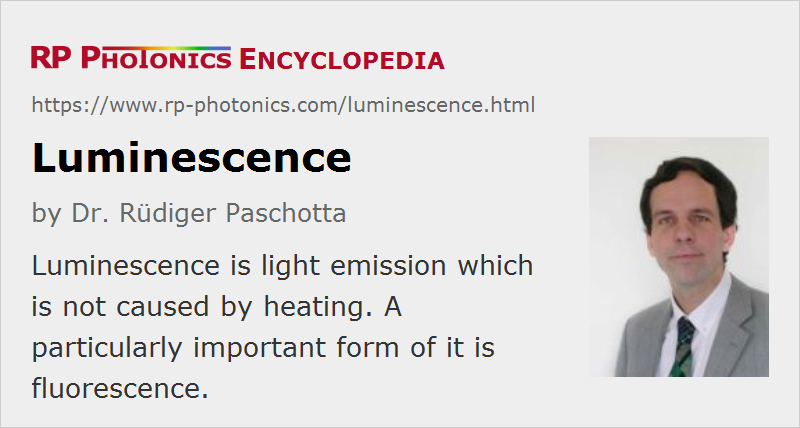Luminescence
Definition: light emission which is not caused by heating
More specific terms: fluorescence, photoluminescence, electroluminescence, radioluminescence, tribolumiescence, thermoluminescence
German: Lumineszenz
Category: physical foundations
How to cite the article; suggest additional literature
Author: Dr. Rüdiger Paschotta
Luminescence (from latin luminare = to light up or illuminate) is a collective term for different phenomena where a substance emits light without being strongly heated, i.e. the emission is not simply thermal radiation. This definition is also reflected by the term “cold light”.
Substances which are made for emitting luminescent light are called phosphors.
Different Kinds of Luminescence
Kinds of luminescence are distinguished according to different criteria – most importantly, based on excitation mechanism, and party the by decay time:
Photoluminescence
Photoluminescence is light emission caused by irradiation with light (normally visible or ultraviolet light) It involves the excitation of electrons into states with a higher energy, from where radiative decay is possible. Decay times are typically of the order of a few nanoseconds, if allowed transitions are involved, but can be much longer in other cases.
In cases with relatively fast decay, for example up to a couple of milliseconds, one uses the term fluorescence, otherwise phosphorescence. The latter involves storage of energy in metastable states and its release through relatively slow (often thermally activated) processes. The phenomenon was discovered early on for phosphorus.
Common sources of fluorescent light are fluorescent lamps, containing a UV-excited phosphor.
Typically, the wavelengths of emitted light are longer than the excitation wavelengths, but there are also upconversion processes where that is not the case.
Electroluminescence
Electroluminescence is light emission triggered by electric influences. For example, the internal flow of electric current e.g. through a p–n junction in a semiconductor device (e.g. a light-emitting diode, LED) can generate electron–hole pairs which produce luminescence when recombining. There are also electroluminescent displays, where a relatively high voltage is applied two electrodes between which there is some kind of organic or inorganic electroluminescent material (a phosphor).
In the case of excitation by free electrons (an electron beam), this is called cathodoluminescence. Here, energy from incoming electrons is mainly transferred by inelastic scattering events, usually producing a large number of electron excitations per incoming electron.
Radioluminescence
Radioluminescence is caused by excitation with nuclear radiation (α, β, γ or ions) or X-rays. It is also called scintillation. It is used in some X-ray detectors, for example.
Triboluminescence
Triboluminescence can occur when a material is mechanical treated, e.g. fractured or polished. It can also be observed when peeling adhesive tapes.
The underlying physical mechanisms are often not totally understood, but can involve some separation of electrical charges, so that electroluminescence may actually be involved.
Chemiluminescence and Bioluminescence
Chemiluminescence is light emitted during (cold) chemical reactions. Here, reaction products are generated in excited states, which decay to the ground state through luminescence.
Bioluminescence is chemiluminescence from living organisms. While it is rarely encountered in everyday life, it is frequently found in organisms living in the deep sea.
Thermoluminescence
Thermoluminescence is a type of phosphorescence which occurs at elevated temperatures. It must not be confused with thermal radiation: the thermal excitation only triggers the release of energy from another source. Therefore, the required temperatures are much lower than those for intense thermal radiation.
Questions and Comments from Users
Here you can submit questions and comments. As far as they get accepted by the author, they will appear above this paragraph together with the author’s answer. The author will decide on acceptance based on certain criteria. Essentially, the issue must be of sufficiently broad interest.
Please do not enter personal data here; we would otherwise delete it soon. (See also our privacy declaration.) If you wish to receive personal feedback or consultancy from the author, please contact him e.g. via e-mail.
By submitting the information, you give your consent to the potential publication of your inputs on our website according to our rules. (If you later retract your consent, we will delete those inputs.) As your inputs are first reviewed by the author, they may be published with some delay.
See also: fluorescence, phosphorescence, electroluminescence, metastable states, phosphors
and other articles in the category physical foundations
 |






If you like this page, please share the link with your friends and colleagues, e.g. via social media:
These sharing buttons are implemented in a privacy-friendly way!